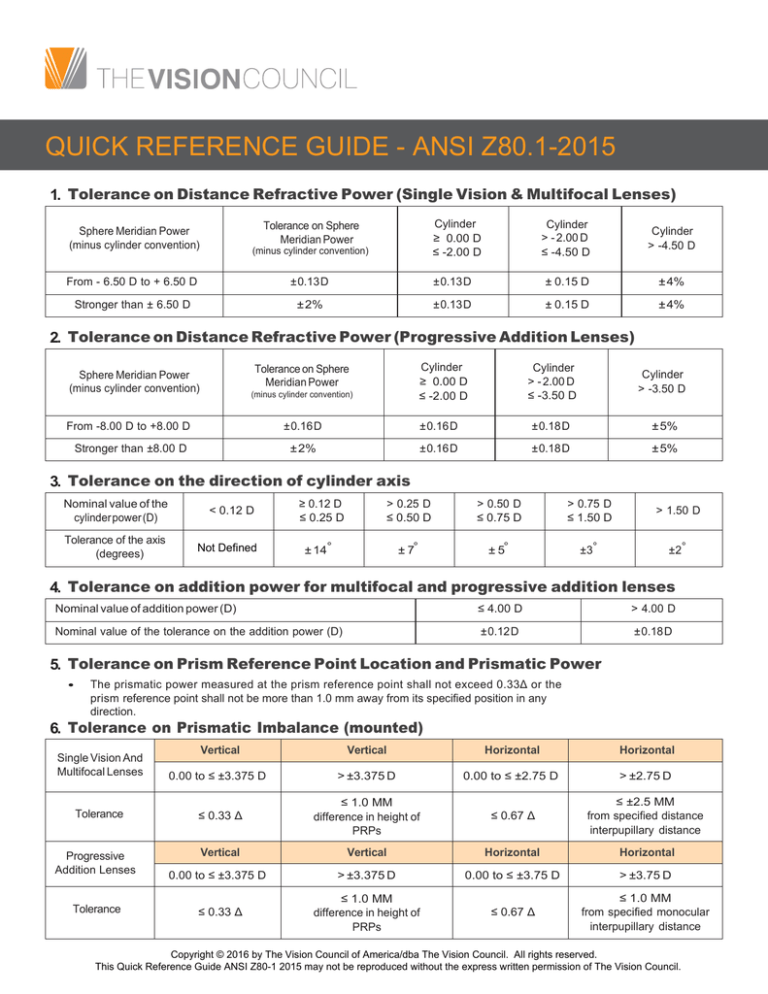
QUICK REFERENCE GUIDE - ANSI Z80.1-2015
Tolerance on Distance Refractive Power (Single Vision & Multifocal Lenses)
Cylinder
≥ 0.00 D
≤ -2.00 D
Tolerance on Sphere
Meridian Power
Sphere Meridian Power
(minus cylinder convention)
(minus cylinder convention)
From - 6.50 D to + 6.50 D
± 0.13 D
Stronger than ± 6.50 D
± 2%
Cylinder
> - 2.00 D
≤ -4.50 D
Cylinder
> -4.50 D
± 0.13 D
± 0.15 D
± 4%
± 0.13 D
± 0.15 D
± 4%
Tolerance on Distance Refractive Power (Progressive Addition Lenses)
Cylinder
≥ 0.00 D
≤ -2.00 D
Tolerance on Sphere
Meridian Power
Sphere Meridian Power
(minus cylinder convention)
(minus cylinder convention)
Cylinder
> - 2.00 D
≤ -3.50 D
Cylinder
> -3.50 D
From -8.00 D to +8.00 D
± 0.16 D
± 0.16 D
± 0.18 D
± 5%
Stronger than ±8.00 D
± 2%
± 0.16 D
± 0.18 D
± 5%
Tolerance on the direction of cylinder axis
Nominal value of the
cylinder power (D)
< 0.12 D
Tolerance of the axis
(degrees)
Not Defined
≥ 0.12 D
≤ 0.25 D
> 0.25 D
≤ 0.50 D
> 0.50 D
≤ 0.75 D
> 0.75 D
≤ 1.50 D
> 1.50 D
± 7°
± 5°
±3°
±2°
± 14°
Tolerance on addition power for multifocal and progressive addition lenses
Nominal value of addition power (D)
≤ 4.00 D
> 4.00 D
Nominal value of the tolerance on the addition power (D)
± 0.12 D
± 0.18 D
Tolerance on Prism Reference Point Location and Prismatic Power
•
The prismatic power measured at the prism reference point shall not exceed 0.33Δ or the
prism reference point shall not be more than 1.0 mm away from its specified position in any
direction.
6. Tolerance on Prismatic Imbalance (mounted)
Single Vision And
Multifocal Lenses
Vertical
Vertical
Horizontal
Horizontal
0.00 to ≤ ±3.375 D
> ±3.375 D
0.00 to ≤ ±2.75 D
> ±2.75 D
Tolerance
≤ 0.33 Δ
≤ 1.0 MM
difference in height of
PRPs
≤ 0.67 Δ
≤ ±2.5 MM
from specified distance
interpupillary distance
Progressive
Addition Lenses
Vertical
Vertical
Horizontal
Horizontal
0.00 to ≤ ±3.375 D
> ±3.375 D
0.00 to ≤ ±3.75 D
> ±3.75 D
Tolerance
≤ 0.33 Δ
≤ 1.0 MM
difference in height of
PRPs
≤ 0.67 Δ
≤ 1.0 MM
from specified monocular
interpupillary distance
Copyright © 2016 by The Vision Council of America/dba The Vision Council. All rights reserved.
This Quick Reference Guide ANSI Z80-1 2015 may not be reproduced without the express written permission of The Vision Council.
7. Base Curve Tolerance
•
When specified, the base curve shall be supplied within ± 0.75 D.
8. Center Thickness Tolerance
•
The center thickness shall be measured at the prism reference point of the convex surface. It shall not
deviate from the nominal value by more than ± 0.3mm.
9. Segment Size & Tilt Tolerance for Multifocals
•
The segment dimensions (width, depth, and intermediate depth) shall not deviate from the nominal
value by more than ± 0.5mm. The difference between the segment dimensions (width, depth, and
intermediate depth) in the mounted pair shall not exceed 0.5mm unless specified.
•
The segment tilt for each lens shall be within ± 2° as measured from the 180.
10. Segment Vertical Location, Tilt and Fitting Cross Vertical Location
•
Multifocals: the segment height for each lens shall be within ± 1.0mm. The difference between the
segment height in the mounted pair shall not exceed 1.0mm.
•
Progressives: the fitting cross height for each lens shall be within ± 1.0mm. The difference between the
fitting cross height in the mounted pair shall not exceed 1.0mm.
•
The horizontal axis tilt for each lens shall be within ± 2° using the permanent horizontal reference markings.
11. Segment Horizontal Location and Fitting Cross Horizontal Location
•
Multifocal lenses: the distance between geometric centers of the segments in the mounted pair shall
be within ± 2.5mm of the specified near interpupillary distance. The inset in both lenses shall appear
symmetrical and balanced unless monocular insets are specified.
•
Progressive addition lenses: the near reference point is set by the lens design. The fitting cross
location in progressive lenses shall be within ± 1.0mm of the specified monocular interpupillary
distance for that lens.
12. Localized Errors
•
Localized power errors or aberrations caused by waves, warpage or internal defects, which are detected by
visual inspection, are permissible if no measurable or gross focimeter target element distortion or blur is
found when the localized area is examined with a focimeter. Areas outside a 30-mm diameter centered on
the reference point, or within 6 mm from the edge, are exempt from this requirement.
13. Prescription Impact-resistant Dress Eyewear Lenses
•
All lenses must conform to the impact resistance requirements of Title 21, Code of Federal Regulations,
801.410 (CFR 801.410).
14. Axis of polarization
•
If there is a marking on the spectacle lens indication the intended direction of horizontal orientation of
polarization, then the actual plan of transmittance shall be at 90 ± 3° from this marking.
Copyright © 2016 by The Vision Council of America/dba The Vision Council. All rights reserved.
This Quick Reference Guide ANSI Z80-1 2015 may not be reproduced without the express written permission of The Vision Council.



